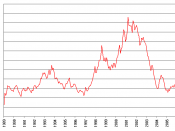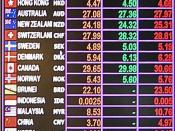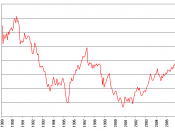The Exchange rate is the price of the Australian Dollar expressed in terms of another currency. The two most common measures of the exchange rate used in Australia are:- The exchange rate against the US dollar.
- The trade-weighted index (TWI). This is a price in terms of a basket of currencies, rather than just one.
The weights for the TWI are revised annually to capture changing trade patterns, occasionally giving rise to changes in the currency composition of the basket. Changes to the weights are usually calculated inSeptember, with the re-defined index spliced onto the existing TWI on the first business day in October.
Exchange rates allow individuals, businesses and governments to buy a foreign currency for importing, investing, travelling, etc. This currency conversion occurs in a foreign exchange market (otherwise known as a forex market). In most financial papers, currencies are expressed in terms of the U.S. dollar, while the dollar is commonly compared to the Japanese yen, the British pound and the euro.
Over the closing decade of the twentieth century the value of the Australian dollar ($A) generally declined against the major currencies (US dollar, UK pound, and Japanese yen). After falling early in the 1990s, the $A had recovered lost ground against both the US dollar and the UK pound by mid 1996, before decreasing, though with a slight increase in mid 1999, into the new century.
The explanation of what determines the exchange rate is a complex and debating issue, but most economists agree on common basic thesis based on the supply and demand curve as market forces which determine the direction of Australia's floating exchange rate since the market deregulation in 1983.
Though, prior to 1988, a complicated equation was used to perceive the exchange rate; this was:Where:The Reserve Bank of Australia...


